Ed Smith And The Imagination Machine: The Untold Story Of A Black Video Game Pioneer
Thirty-seven years ago, New York-based APF Electronics, Inc. released The Imagination Machine, a hybrid video game console and personal computer designed to make a consumer’s first experience with computing as painless and inexpensive as possible.
APF’s playful computer (and its game console, the MP1000) never rivaled the impact of products from Apple or Atari, but they remain historically important because of the man who cocreated them: Ed Smith, one of the first African-American electronics engineers in the video game industry. During a time when black Americans struggled for social justice, Manhattan-based APF hired Smith to design the core element of its future electronics business.
What it took to get there, for both APF and Smith, is a story worth recounting—and one that, until now, has never been told in full.
Edward Lee Smith was born in Brooklyn, New York, in 1954. He grew up in Brownsville, an impoverished neighborhood within the borough. His parents moved there from Mississippi a few years prior, and they weren’t alone. Between about 1910 and 1970, millions of black families like the Smiths fled north in a Great Migration, as historians now call it, to escape the terrors of the American South during the Jim Crow era.
What his parents found when they got to New York wasn’t much more promising than the South: Government policies and widespread racism kept black residents concentrated in small areas of low opportunity and high poverty. Places like Brownsville were the result. The neighborhood had once been primarily occupied by Jews, but later became known as a black ghetto, replete with scenes of crime and misfortune that unfolded every day. It was in this environment that Ed Smith came of age, the third eldest of six brothers and sisters, in a public housing development called Nobel Drew Ali Plaza. His mother was a domestic, and his father, an Army veteran, drove trucks for a living.
Early on, Smith’s father told the younger Smith not to expect any greater aspirations for himself. “Get your chauffeur’s license so you can learn how to drive a truck,” Smith recalls him saying, “because that’s all you’re ever going to do.” And yet such expectations could not suppress Ed Smith’s intense curiosity about how things worked. He began taking apart everything he could, and he soon taught himself to repair basic electrical gadgets like toasters and irons. Later, he moved on to radio receivers and TV sets. Smith’s electronics skills came in handy as he began doing odd jobs around the neighborhood to help make ends meet for his family. At times, he largely provided for himself.
Through exposure to books and TV, Smith learned about the larger world outside of Brownsville. He devoured epic science fiction works and titles by black intellectuals such as Ralph Ellison’s Invisible Man and the works of W.E.B. Du Bois. As his knowledge of the world grew, Smith began to feel like Brownsville was his personal cage, holding him back from greater opportunities. He recalls the many times he sat at his window, watching the traffic on the busy four-lane street outside. “My only wish was to be sitting in one of those cars, driving down Eastern Parkway,” he says. “Anywhere, any direction, I didn’t care. I just didn’t want to be there.”
It was a tough life, but he tried his best to steer his own fate. At age 13, Smith recalls waking up to a commotion, his sisters and brothers crying. In another room, he found his mother on the floor, his father pummeling her with fierce blows. Smith tried to pull his dad off, but the elder Smith knocked him unconscious. When the teen came to, he grabbed a frying pan from the kitchen and knocked his father out. “I dragged him out of the house and locked the door,” recalls Smith. “That was the last time my father ever came into our home.”
1968: Creation And Chaos
In January 1968, two brothers named Albert and Philip Friedman, both veterans of the consumer electronics industry and Asian import specialists, founded a technology company named after their initials: APF Electronics, Inc. The new firm opened an office on Madison Avenue in Manhattan and got to work quickly, making deals to bring in the latest transistorized calculators and stereos from Japan.
Albert Friedman, the company’s first president, then in his 60s, had previously worked for Olympic Radio, then later served as president of Delmonico International—the first company to import Sony products to the United States. His brother Philip grew up in prewar Japan, steeped in Asian culture, and had for decades been an essential liaison to U.S. firms that sought to do business with the Far East.
The pair hired other Delmonico veterans to fill out APF’s initial team, including Seymour “Sy” Lipper, who took on a marketing role, and Irving Boilen, an electronics engineer that would serve as the head of their new engineering department.
On the broader American stage, 1968 marked a tumultuous low point in a decade that saw rapid social and technological change. While the Vietnam War weighed heavily on the nation’s collective conscience, it was a domestic event that set the chaotic tone for the rest of the year: On April 4, James Earl Ray shot and killed Martin Luther King, Jr., as he stood on his motel balcony in Memphis.
The assassination of the U.S.’s most famous proponent of black rights triggered riots in many communities around the country, including Brownsville. The day after King was killed, 14-year-old Ed Smith sat on a street corner, watching in disgust. “I remember all of the looting going on around me,” he recalls. “People were taking bricks and throwing them into white people’s cars. It was mass rioting.” The experience solidified his resolve: He was going to find a path out of the projects.
Smith’s friends were skeptical of his passionate interest in electronics. “When they heard what I was doing, they would say, ‘You would never understand that, a black guy can’t do this kind of thing. It’s not your world. They will laugh you out of the room,'” he says. The negative remarks only served as a challenge to Smith, who sought to prove them wrong.
During his last year of high school, Smith met his future wife, Sheila, and unexpectedly found himself becoming a father at age 18. The desire to provide for his family intensified Smith’s drive, and after graduation, he started working full time doing electrical odd jobs like wiring security systems.

In 1972, Smith moved to Coney Island and landed a position at Brooklyn-based Marbelite, one of the nation’s largest manufacturers of traffic signals. The job gave Smith his first taste of digital electronics technology, which would drive consumer electronics of the 1970s, ’80s, and beyond.
Behind every traffic signal is a device called a traffic controller—a timer that keeps track of when to turn on and off certain lights. Prior to the 1970s, most controllers relied on electromechanical parts, but the boom in solid-state electronics saw the controllers become transistorized in the early 1970s. In 1971, Intel had introduced the first commercial single-chip microprocessor, launching a new era in electronics. Just as other industries scrambled to incorporate the new technology into their products, it wasn’t long before Marbelite wanted to use the power of a microprocessor to control traffic signals.
To that end, Marbelite paid for Smith, who was then working as a technician, to attend local vocational classes on microprocessor-based circuit design. He learned to program the brand-new Fairchild F8 microprocessor (coincidentally the same chip used in the Fairchild Channel F, the first cartridge-based video game system in 1976). The classes brought big dividends to Smith, who soon leveraged the knowledge to get a taste of life in other parts of the Big Apple.
Of Calculators And Video Games
By 1972, APF Electronics had established itself as a leading manufacturer of desktop electronic calculators. In fact, the firm was doing so well that it contracted Sy Lipper’s brother, Martin “Marty” Lipper, as a specialist to take the company public that November. Looking back, Marty (who joined APF full time as its CFO in 1973) emphasizes the role of calculators in the company’s early success. “We built 70% of all the calculators ever sold at Sears in those days,” he recalls. “The same goes for Montgomery Ward.”
Calculators would carry APF’s business forward until the next great revolution in consumer electronics came along: video games. Just as APF was going public in 1972, a young California company called Atari made waves nationwide with Pong, an arcade video game sensation that soon spawned dozens of shameless rip-off games and launched a wider arcade video game industry. Ironically, Pong itself was a shameless (but improved) rip-off of the first home video game system, the Magnavox Odyssey, which launched just a few months earlier.
In December 1975, Atari released the home console version of Pong through Sears under its Tele-Games label, and it proved wildly successful. Like it had done in the arcades, Pong as a home product inspired dozens of knock-offs, most of which were built using a custom “Pong-on-a-chip” integrated circuit created by General Instruments called the AY-3-8500. The mass production and general availability of this chip, and several follow-ups, made the engineering of dedicated “ball-and-paddle” consoles almost trivial affairs, with more work going into their plastic cases than into the electronics within.
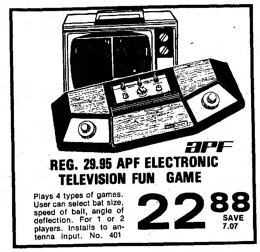
In 1976, APF became one of dozens of firms that jumped headfirst into the home video game market, releasing its first Pong-like decidated console, the TV Fun. It was a sleek, compact, plastic cabinet with faux woodgrain and silver trim and two built-in rotary knobs that contained four built-in variations of the simple ball-and-paddle game. While the TV Fun utilized the same Pong-on-a-chip circuit that many other manufacturers used in their own clone consoles, APF’s model quickly became one of the best selling on the market, moving 400,000 units within its first year—a stunning figure at the time.
Over the next two years, APF followed the first TV Fun with several improved models that added more games and a light gun, although sales dropped with each successive unit as the market became increasingly saturated with Pong-like consoles.
APF also found, as other companies did, that it became prohibitively risky to keep releasing new dedicated consoles—which often needed their own distinctive cases, circuitry, and marketing campaigns—to accommodate new types of video games. The solution to this problem first entered the market in 1976 with the Channel F, which was codesigned by an African-American engineer, Jerry Lawson. The Channel F approach allowed the sale of one universal console player device and many smaller, less expensive game cartridges that would add lasting appeal to the system.
An interchangeable, programmable approach to video games required the games to be written as software and run through a microprocessor—in other words, it meant designing a computerized video game system. From APF’s point of view, creating such a console would require specialized expertise that few engineers at the company had developed. That led to the search for a new hire who could help design a new console that would lead APF into the next generation. Thanks to Marbelite, they would soon find their man.
Manhattan Bound
Ed Smith loved his job at Marbelite; it introduced him not only to new concepts in electronics, but also to a wider world. While attending his microprocessor classes, he visited Manhattan and took special notice of Wall Street brokers that projected a fancy, clean-cut look. “I definitely wanted to be that kind of person,” he recalls. “Somebody who would be able to dress for success.”
With that aim in mind, Smith signed up with an employment agency, and soon he landed a job interview with APF Electronics in midtown Manhattan. There he met Kenneth Boilen, the son of Irving Boilen and one of APF’s chief engineers. After a brief greeting, Boilen introduced him to another engineer named Craig who sat Smith down at a table with a schematic and said, simply, “Build that,” then left the room.
Smith found the task fairly simple; he completed the construction just after lunch. An hour later, Craig returned, surprised to see the task complete. “You’re done?” he asked Smith in amazement, to which Smith replied that he had been finished for some time. Soon after, Craig reported to his superiors: “This guy knows what he’s doing.”
Just like that, Smith landed his dream job in buttoned-down Manhattan.
According to Marty Lipper, Smith’s race never played a part during the hiring process at APF. “The man was an engineer, and he knew his business,” he recalls. “When we interviewed him, he was a decent guy, and that’s all I cared about.” Still, it’s a reflection of APF’s culture that it chose, in the mid-1970s, to hire a black man who grew up in one of the most impoverished neighborhoods of New York City to design the linchpin of its future electronics business.
When pressed, Lipper emphasizes the diversity of the company’s workforce. He recounts an episode when he got a call from the Department of Labor, informing APF that it was being sued for being anti-Semitic. “I started laughing on the phone,” he recalls. “And the one from the labor department says, ‘Mr. Lipper, this is not a funny situation.'” Lipper went on to explain that APF’s entire upper management team was Jewish. “I told them, ‘We have 150 employees. Twenty-five percent or 30% have to be black. We have about 50 Chinese. We’ve got Middle Easterners, you name it. We’re the League of Nations.’”
Both Marty Lipper, a Korean War vet, and his older brother Sy—the firm’s president when Smith was hired—describe living lives steeped in diversity. Sy Lipper, who is now 90, grew up during the Great Depression in a poor Jewish ghetto in the Bronx. Later, he served in the European theater during World War II alongside a diverse cast of characters from all over the U.S., some of whose deep poverty meant that their government-issued combat boots were the first pair of shoes they ever wore. He also witnessed liberated Nazi concentration camps firsthand, and he says these experiences gave him a deep appreciation for the opportunities available to him in his home country—and of those denied to others. “I got to see what was going on elsewhere in the world, how people were living,” recalls Sy. “I saw that what [my family] had was so much better, even though we had nothing.”
Nine years his brother’s junior, Marty Lipper recalls attending the first integrated high school in New York City, Morris High School, where he took classes with future Secretary of State Colin Powell, whom he knew well.
In the minds of APF’s management, there was never a question of whether or not to hire a black man. Smith was fully qualified for the job. That’s how he became not only APF’s first microprocessor specialist, but also (after Fairchild’s Jerry Lawson) the second known black engineer in the history of video games.
The MP1000 Story
At APF, Ed Smith “learned to translate binary code pretty fast,” he remembers. “I learned the motto of any good engineer, which is “plug it in and let’s see if it blows up.” After getting established, he took the opportunity to go back to school part-time, studying computer science and marketing at Pace University. Three days out of the week, he would leave Brooklyn, go to work in midtown, leave for Pace in lower Manhattan, then come back home at night.
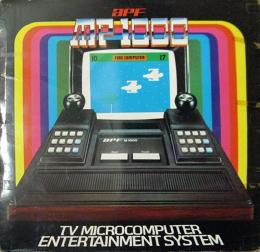
Around 1977, an engineering crew at APF, led by Kenneth Boilen, began work on the firm’s first cartridge-based video game system. Ed Smith took the lead on designing the prototype for the console, drawing from a wide range of inspirations like the Apple I and TRS-80, but ultimately coming up with a unique design based on the Motorola 6800 microprocessor—an unusual CPU choice in the industry at the time, which was handed to him by his boss.
With contributions from APF’s design team and engineers in Hong Kong, Smith developed the console’s electronic design through numerous iterations over the course of six months. Meanwhile, the company’s marketing department christened the new product the MP1000 (MP for “microprocessor”).
What APF came up with was a small, black plastic video game unit with silver buttons and woodgrain trim. The MP1000’s base doubled as a stand for two hard-wired hand controllers, each with a joystick, a large fire button, and a 12-button numeric keypad. The system generated blocky color graphics and contained one built-in game, Rocket Patrol.
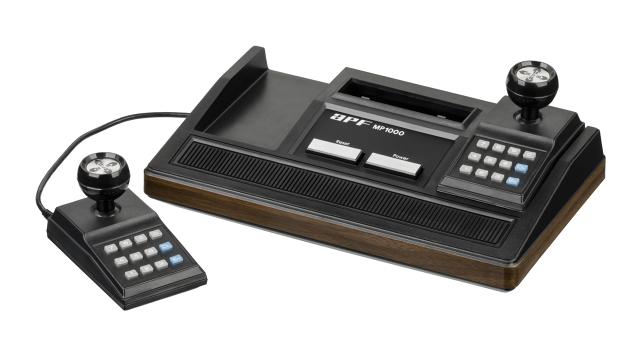
Most importantly, the MP1000 also played games sold separately on removable cartridges, with each cartridge including multiple game variations that were selectable from an on-screen menu. After design was complete, Smith recalls his job as switching to play-tester for a time. He learned to complete every game on every difficultly level, and it became a mind-numbing chore before long.
The MP1000 launched commercially in mid-1978. It sold well initially, but received mixed reviews from the press. On the positive side, with the home video game industry being as new as it was at the time, there was still a general sense of wonder among the public that games could be played on a TV set at all, and thus the bar for game quality was relatively low. As such, not much public criticism was levied on the quality of the MP1000’s individual games.
Meanwhile, Atari retained the industry’s sales lead with its cartridge-based console, the VCS (later known as the Atari 2600) thanks to home ports of its hit arcade games. Through its coin-op division, Atari mastered the design of visceral, action-based gameplay that attracted players and kept them coming back for more, raising the bar on perceptions of home video game quality dramatically during the last few years of the 1970s. Notably, in the press, Atari’s games stood out as individual cultural works worthy of review and attention separate from the VCS console itself.

In contrast, APF fared poorly in regard to game quality and innovation. At a time when Atari’s games often featured tanks, jets, race cars, dragons, and haunted houses, APF’s MP1000 offered low-energy games like Bowling, Backgammon, Hangman, and Tic-Tac-Toe. The few action games the MP1000 had often involved no more coordination than timing when to push the fire button to shoot a single spaceship flying slowly across the top of the screen.
Most of APF’s games had been programmed by one man, a British expat named Harry Cox. According to the Lippers, APF could hardly spare the capital required to hire additional programmers. (The question of third-party game software, a business pioneered years later by Activision, did not enter their minds.)
Sy Lipper describes a huge culture clash between WW II-era upper management, who expected rigid nine-to-five schedules and clockwork production, and the new generation of laid-back baby boomers who they hired to write the software. Game development is an inherently artistic and creative process, and that proved difficult for many 1970s consumer electronics companies to grasp. Among the first batch of game console companies, Atari alone embraced the creative artistry of game design, and that fact above all others allowed the firm to dominate the industry.
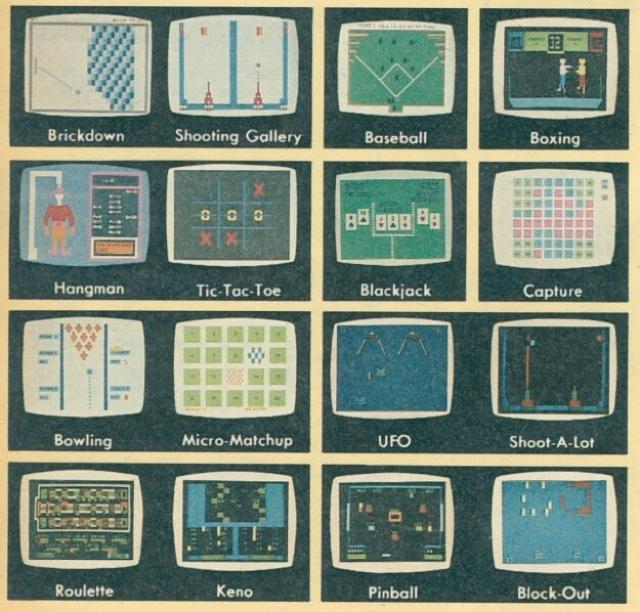
Upon the launch of the MP1000, Ed Smith felt deep personal satisfaction from the completion of the project—the first commercial consumer product he had ever worked on. Thanks to nimble work by APF’s sales team, the console was available through large merchandisers like Sears and Montgomery Ward.
One day, Smith visited a local Sears department store like a proud father, excited to see his progeny on the shelves. The trip quickly turned bittersweet as he beamed his pride to a salesman. “I said to the sales guy, ‘I’m one of the guys that designed this,'” and he goes, ‘Yeah, right.'”
Back in the lab, Smith was always conscious of how skin color limited opportunities for African-American kids in the projects, most of whom would never get a chance to play home video games because their parents couldn’t (or wouldn’t) buy a game console themselves. He saw an opportunity to help.
After the launch, APF began to stockpile spare and returned MP1000 consoles for demonstration and testing purposes. Roughly 300 consoles sat unused in the back of a closet at APF headquarters, ultimately destined for scrap. “Every other day I would take a console back home to the neighborhood and give it to someone in the projects that I lived in,” recalls Smith, who lived in Flatbush. “So, when I was done, there were probably a good 50 people that I knew in the projects playing the MP1000.” Smith, who considered his unsanctioned experiment not only a charitable exercise but part of play-testing, became impressed with the reaction he witnessed.
“They didn’t know what to expect,” says Smith, “But once they got it in front of them, it was all intuitive. They loved it. It was a chance to interact with someone else in the apartment versus going outside and doing something crazy. So a lot of times, people would play the video games for hours in the day, like they do today, and not be on the street.”
The Imagination Machine
Around the time the MP1000 was in its planning stages, APF’s head of engineering, Irving Boilen, spearheaded the firm’s first personal computer project, the PeCos One (short for “Personal Computer One”). According to Sy Lipper, it was Boilen who chose to base the machine around an obscure defense contractor programming language called JOSS rather than BASIC, the industry standard. That one decision ensured the quick market death of the awkward computer upon its launch in 1978.

The failure of the PeCos One would not keep APF from trying again, however. The Apple II, launched in 1977, had proven there was a strong market for easy-to-use personal computers for consumers, and APF wanted in on it. Others did too. During the development of the MP1000, APF’s management heard news of Mattel’s upcoming Intellivision console, which the toy giant planned to later transform into a full-fledged personal computer using a separate keyboard. Hoping to get a jump on the competition, APF decided to pursue that path as well, using Smith’s microprocessor-powered MP1000 as the core of a larger computer system.
The Imagination Machine debuted to the press at the 1979 Summer Consumer Electronics Show in Chicago with the clever name thought up by Irving Boilen’s son (and Kenneth’s brother), Howard Boilen and another APF employee named Gary Sharp. APF’s marketing materials emphasized the Imagination Machine’s potential as a creative tool for music, art, language, education, and programming.
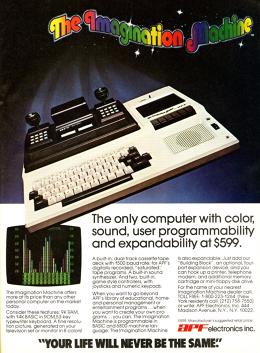
What the firm showed off at CES was a large off-white computer base unit with an integrated full-sized, full-stroke keyboard and a built-in cassette tape drive for data storage. The base unit and console would be mated via a J-shaped connector that plugged into the MP1000’s cartridge port. With the two units combined, the Imagination Machine relied on the Motorola 6800 CPU in the MP1000 and added an additional 8K of RAM, making for 9K of memory in total.
The Imagination Machine, as a $599 personal computer, received very wide press coverage in magazines and newspapers across the U.S. at a time when a 16K Apple II Plus retailed for $1,195. Its playful logo, combined with its emphasis on ease-of-use and creativity, were attractive targets for journalists writing roundups of the first-ever wave of lower-cost, family-oriented “home computers” that arrived from manufacturers like Atari, Texas Instruments, and Commodore during the last few years of the 1970s.
To target the Imagination Machine at a home audience, APF decided to rely on traditional retail channels as it had with its calculators and video game products. But unlike the MP1000 alone, the Imagination Machine was a fully programmable microcomputer, which was inherently trickier to operate—and much harder to sell to a suite of retail executives who often possessed no technical background whatsoever.

To bridge this gap, Ed Smith’s boss, Kenneth Boilen, approached Smith one day with an offer that would completely change his career trajectory. “We’re going to change your role to a technical specialist,” Smith recalls them saying. “And we want you to go to Sears and talk about the Imagination Machine.”
Smith embraced the opportunity now laid out before him: “I threw on my suit and [grabbed] my briefcase, and I’m off to Chicago.” During a large lunchtime sales call, Smith found himself in Sears Tower, then the tallest building in the world, pitching APF’s new computer to Sears executives. “The sales person is there and he’s hearing my pitch, and I’m talking about RAM and ROM and all of the inputs and outputs.”
Smith breezed through the presentation, and at the end, the former resident of Brooklyn’s poorest neighborhood, whose father had told him that he could expect no greater career than truck driver, stopped at a window and paused in a moment of triumph mixed with astonishment. Looking past his own reflection, he says, he saw the Chicago skyline and thought, “How far I have come.”
APF Closes, Another Door Opens
The Sears meeting was one of the highlights of his career, Smith says, but it was only the beginning of a new era for him. Back at the office a couple weeks later, an APF sales rep approached Smith at his engineering drafting table and slapped him on the back. “Ed, you did so great,” he said. “You just made me ten grand this month.” Smith’s jaw dropped. At the time, he earned about $20,000 a year.
“I got up from my drafting table, and I walked over to Howard Boilen, who was the VP of sales, and I said, ‘Howard, if I’m going to pitch this, don’t you think I should sell it?'” Boilen, pleased with Smith’s performance at the Sears meeting, agreed, and Smith soon switched from engineering to sales. “I started selling the machines that I helped to build,” says Smith.
Throughout 1980, Smith traveled the country showing off the Imagination Machine to executives at department stores and computer retail chains, with a string of optimistic successes. However, big-name retail support for the Imagination Machine could not make up for shortcomings in the computer’s design.
Today, Smith recalls that APF’s marketing department insisted on including a tape recorder with the system. The engineering team resisted, but marketing won out. APF’s cassette-bound machine launched over a year after Apple had rocked the personal computer world with its low-cost Disk II drive, making slower, less reliable cassette drives commercially unattractive. And yet there it was, permanently built into each unit.
1980 passed with very modest sales of the MP1000 and the Imagination Machine, and in January 1981, Smith traveled to CES for the last time as an APF employee to demonstrate the Imagination Machine II, a remodeled unit with more memory and integrated MP1000 circuitry that looked nearly identical to the original except for a smooth surface on its top where the core console used to sit. Strangely, it retained the built-in cassette drive, but alongside the $399 base unit, APF pitched a complex “System III” constellation of peripherals and disk drive add-ons that upped the price of the machine to a far less appealing $1,195.
Such incremental, expensive improvements did not improve sales, and in the face of heavy competition from Apple, Atari, Commodore, and Texas Instruments, APF’s PC failed to gain significant market share. Still, the company’s management sought to keep going and try again. In fact, the Lipper brothers insist that sales of all its products were good enough to sustain the company into the future. “Nothing we did was a disappointment,” says Marty Lipper with perhaps a hint of rosy glasses. “Everything we did worked out either good or excellent. We were making money, there was no problem.”
The core reason for APF’s downfall, according to Sy and Marty Lipper, centered on the skepticism of the two New York banks that held APF’s lines of credit—the loans that APF relied on to fund production runs. Marty Lipper recalls the scene: “The banks said to me, ‘You have three businesses, and we don’t think there’s any future in TV games because that’s a fad. And this personal computer nonsense, there’s no future for them. The public doesn’t want or need them. But if you stay in the calculator business, we’re not going to call the loans. We’re happy with that business.'”
Sy and Marty Lipper refused to cave in to the banks’ demands, knowing that calculators, which had become a low-priced commodity at that point, did not represent the future of the consumer electronics industry. “The banks could not understand the personal computer,” says Sy Lipper. “Because as far as they were concerned, it was a toy, and the computer itself was in the hands of IBM.”
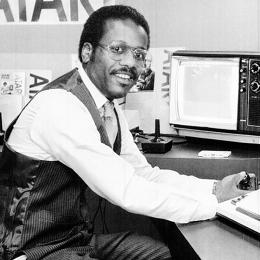
In 1980, the market capitalization of Apple, one of the most successful personal computer companies up to that point, was still minuscule compared to IBM. It wasn’t until August 1981 that IBM would release its Personal Computer and legitimize the market in the eyes of the banks. By then, it was too late for APF.
The Lippers warned their staff of an impending shutdown, giving them time to find new jobs, and making sure to pay the employees what they were due. “Ken Boilen, one of the best bosses and best friends I’ve ever had, was always honest and straightforward with me,” says Smith. “He came to me and he said, ‘You know, the company is not going to make it. We’re not doing well with this thing, and I don’t want you to get stuck here and be on unemployment and not take care of your family. You should go look for something else.'”
During a final tense meeting that Sy and Marty Lipper had with its credit lenders, bank officials threatened one last time: Leave the video game business or immediately repay your $7 million debt in full. Marty stood up, pulled the company’s office keys from his pocket and set them on the table. He urged his brother to do the same, then said, “Here it is. The company is now yours.”
APF Electronics effectively ceased operations in 1981 and never declared bankruptcy, although it took some years for the banks to fully wind it down.
“Being One Of The First To Do Anything Is Amazing”
When Ed Smith moved on from APF, he also left the video game field. “Frankly, had I the forethought to know the industry would become what it is today, I would have stayed the path,” he says.
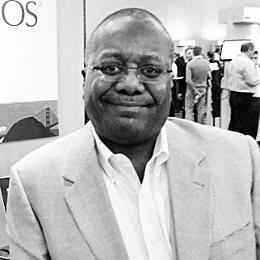
Still, his experience at APF stuck with him. “I learned to develop myself from an introverted bench guy to an extroverted corporate speaker,” he explains. “I learned to take alternate paths when one seems to be clogged. Mostly, I learned to trust my abilities and to never think I was any less capable than anyone else.”
After APF, Smith spent four years managing an Apple dealership in upstate New York. Then he worked at a computer dealer in Albany and helped expand a computer chain called The Computer Factory to a new location in Philadelphia. Another fresh start came when he signed on with PC networking pioneer Novell during its formative period.
At that point, like Smith, all of his brothers and sisters had established careers for themselves and escaped life in the projects. But over a decade after Smith had moved out, his mother still lived in public housing, among high crime and badly maintained facilities.
One day in the mid-1980s, he drove from New Jersey to Brownsville in a U-Haul moving truck. Neighborhood regulars looked on with skepticism as he stepped out and entered his mother’s apartment. A few minutes later, he returned with armfuls of his mother’s possessions and began loading the truck.
“Where are you taking her?” Smith recalls neighbors asking with incredulity. “I’m taking her out of here,” he replied. As the rolling U-Haul door closed shut and he stepped into the cab, Smith heard someone say, “Whoa, he’s actually doing it.” He moved his mother to a apartment not far from where he lived in New Jersey, and two years later, he bought her a condo, freeing his family from the projects at last.
Today, Smith is still a successful tech salesman, although he is nearing retirement. He has been married to his high school sweetheart for 40 years and his kids are now grown with their own families.
A few decades removed from his work at APF, Smith has a new appreciation for what it meant. “Funny, when you are head-down doing the work, the last thing you think about is being an African-American,” he says. “You’re just another engineer doing his job. Once you have a chance to digest what you’re able to accomplish, time passes by because you are head-down on the next thing.”
In retrospect, he adds, “I can say with certainty that being one of the first to do anything is amazing. To be a man of color and a leader in the video game industry will be my legacy, and one that I am very proud of.”
Fast Company , Read Full Story
(38)


